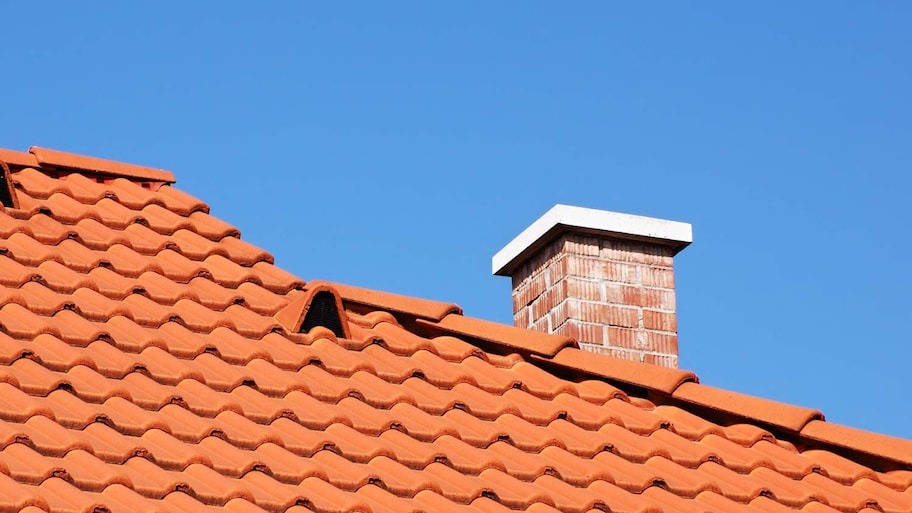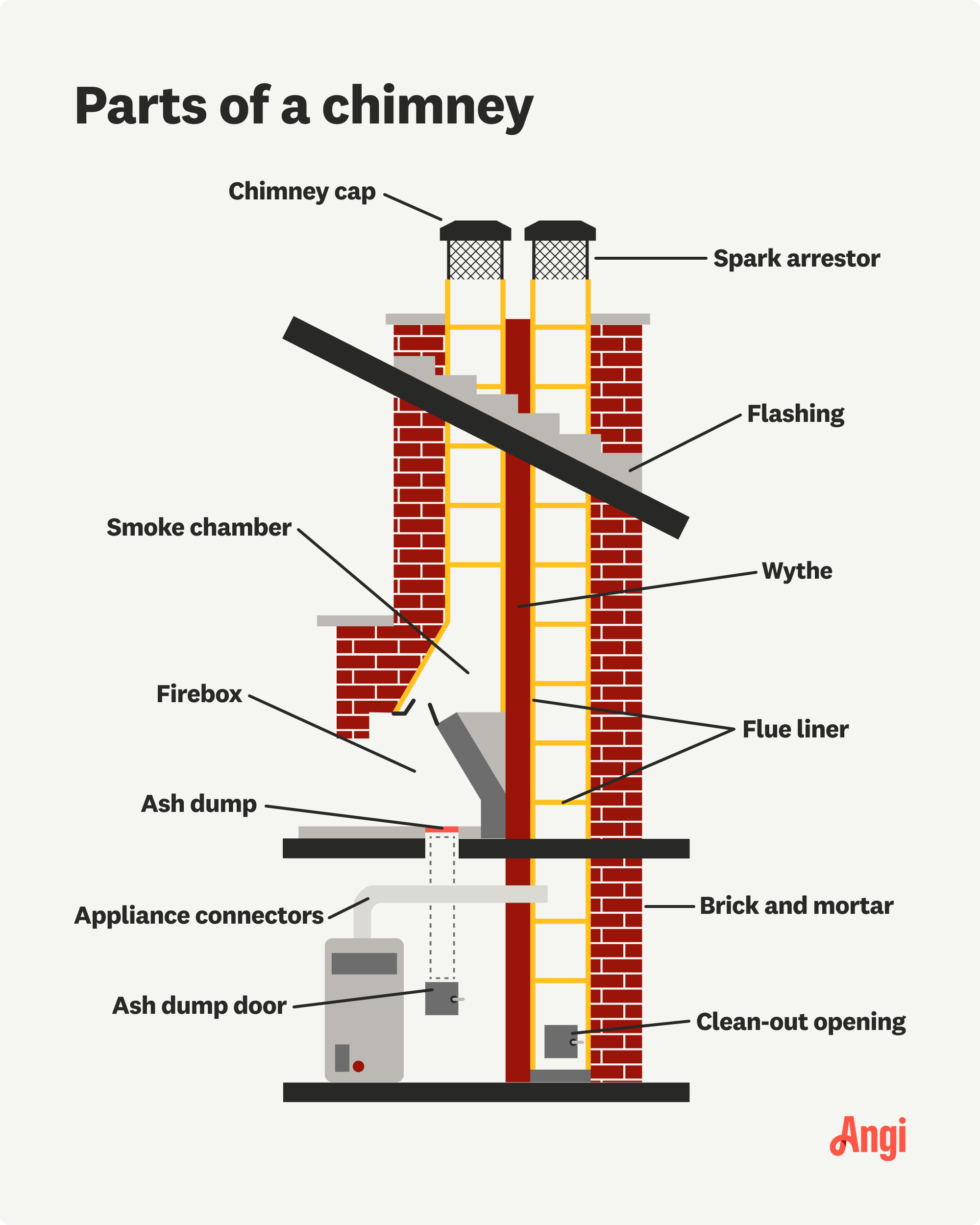Parts of a Chimney and How They Work
These 15 components make up the core of the chimney anatomy


Highlights
The anatomy of your chimney is more complex than you might think.
Internal parts of a chimney include the appliance connector, ash dump, damper, smoke chamber, and firebox.
External chimney parts include the chimney cap, chimney crown, and brick and mortar.
Get your chimney inspected every year by a professional to ensure it’s operating safely and efficiently.
Your chimney serves as the main ventilation point for your cozy fireplace or furnace. It has several different parts to keep the air flowing correctly, keep animals out, and even catch any dust and ash that falls from your heater or fireplace.
While you probably don’t need to understand all the nuances of how your chimney works, it’s useful to understand the different parts of a chimney, what they’re used for, and how to maintain them. Below, we’ve broken down the anatomy of a chimney—including both internal and external components.

Internal Chimney Parts
Despite picturing a chimney as that external brick entry point for Santa on top of the house, many of the most crucial parts of a chimney are actually internal (and homes can have chimneys without having fireplaces).
Here’s a full rundown of all the internal parts of a chimney you should know.
Appliance Connector
This piece connects a furnace or water heater to the chimney to create the ventilation system. Whether your home has a separate chimney or a connected one will come down to individual floor plans.
Ash Dump
If your chimney connects to a wood-burning fireplace, all that ash from burning the firewood needs to go somewhere: into the ash dump to collect. Ideally, you’ll want to empty this area several hours after the last ember dies down to ensure the ashes are no longer hot.
Ash dumps are constructed from non-combustible masonry materials to ensure there’s no chance of this area igniting from ash. Always try to handle this area with care and never directly touch the ash.
Ash Dump Door
This is the door to the ash dump. The door itself must seal to ensure the hot ash doesn’t leak into the rest of your home. It also helps to stop excess heat from the ash from escaping into your house.
Clean-Out Opening
If debris manages to get past the chimney crown cap and the spark arrestors (more on those below), the clean-out opening will catch it. The clean-out opening is very deep down into the chimney flue and closer to where the fire originates. Don’t wait for your annual chimney inspection: You should periodically check the clean-out opening to ensure everything is clean.
Firebox

Fireboxes may be the most recognizable of a chimney's internal parts, but they only apply to chimneys that connect to a fireplace. This is the interior (also brick-and-mortar) portion. Because it’s directly next to the flames, these bricks must have a higher flame resistance.
You should clean your firebox regularly—outside of the annual chimney cleaning—to keep it operating efficiently. Make sure you know how to clean a brick fireplace.
Damper
Another chimney component that accompanies the actual fireplace, if you have one, is the damper. Chimney dampers are made of iron or steel so they can stand up to the high heat of your fireplace.
These mechanisms allow you to control the flow of smoke through your chimney flue. Open the damper when you have a lit fire and while you’re waiting for your fire to go out. Then keep it closed when the fireplace is not in use. This keeps the inside air in and the outside air out.
Flue and Flue Liner
The chimney flue is the part of a chimney in which the smoke rises to exit your home. Water heaters and furnaces that vent through a chimney also have a flue.
To protect the masonry of this vertical chute, the chimney flue is lined by a flue liner, also called a chimney liner. A chimney liner can be made of stainless steel, aluminum, clay, terracotta, ceramic, or a cast-in-place cement mixture. Installing a chimney liner costs an average of $2,500.
A chimney sweep will thoroughly investigate and clean the flue and flue liner during your annual inspection. On average, a chimney sweep cleaning costs $255.
Smoke Chamber
The smoke chamber bridges the gap between the firebox portion of your fireplace and the flue liner of your chimney. Constructed in pyramid shapes, it funnels smoke and gas directly into the flue liner and out of the home.
Smoke Shelf
The smoke shelf plays a crucial role in chimney anatomy. It collects debris and rainwater that enters through the chimney and descends down the flue. The smoke shelf also helps prevent downdrafts from entering your home.
Wythe
Some houses have more than one chimney. In this case, a wythe, which is simply an interior masonry wall, helps prevent the heat from building up too much if both chimneys are in use at the same time.
External Chimney Parts
The external parts of a chimney include the crown, cap, and brick and mortar that make up the chimney itself. It’s important to have both internal and external components inspected every year. If the inspection turns up any issues, find a trusted chimney repair contractor near you to address the issues as soon as possible.
These are the main external chimney parts to prioritize during your inspection.
Brick and Mortar
On the exterior, brick and mortar commonly connect chimneys to a fireplace. Brick and mortar is an excellent material for fires, as they can withstand high heat without catching fire.
Over time, the brick chimney may require tuckpointing, a type of restoration that replaces old, failing mortar with new mortar. Tuckpointing costs between $5 and $25 per square foot.
Chimney Cap
A chimney cap sits atop your chimney and prevents water, ice, and debris from blowing into your chimney. That way, you can still have a roaring fire going even when it’s snowing or pouring rain.
If you notice your chimney cap is missing, you should replace it ASAP to avoid anything coming down the chute. A chimney cap replacement costs around $300.
Chimney Crown
Like the chimney cap, a chimney crown sits atop the chimney. However, the crown is a flat slab of concrete that covers the entirety of a masonry chimney, while the cap simply covers the smaller opening through which smoke billows.
Like the cap, the chimney crown is crucial for keeping weather, debris, and animals from entering the chimney. If yours is damaged, it’s crucial to fix it quickly. Chimney crown repair costs an average of $1,550.
Flashing
The flashing around your chimney prevents weather from entering your home. Unlike a chimney cap, which would only prevent things from entering the chimney, flashing prevents ice or rain from entering your attic. The cost to repair chimney flashing ranges between $150 and $500 while total replacements can cost as much as $1,600.
Spark Arrestor
Spark arrestors act as a second line of defense against Mother Nature. If your chimney crown cap fails, the spark arrestor will catch these items. But since it’s catching rather than preventing them from entering altogether, you’ll need to ensure it’s cleared before installing a new chimney cap.
Frequently Asked Questions
Chimney repairs cost between $160 and $750, or about $455 on average. This includes routine repairs like repointing, replacing a cap, or minor repairs to the lining. The type of chimney you have, where you are located, and the extent of the damage to your chimney will all factor into the price.
A chimney sweep will clean and inspect your chimney for about $130 to $380. This service includes regular maintenance as well as an inspection for any necessary repairs, but it won’t include the cost of those repairs. The type of chimney you have will affect the cost of hiring a professional chimney sweep.
